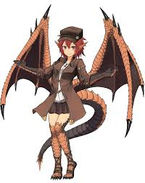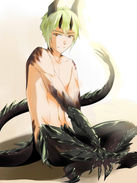M. Schlein J-11
Painting Fur and Scale Textures
Fur and scale textures are combined on this page because they are made in a similar manner. For both of these textures, the base color is applied first. Shadows and highlights may also be applied to this base coat.
The fur and scales don't need to be extremely detailed across the whole body. The foremost areas will have more intense values of lights and darks in each scale and/or cluster of fur. The most intense line details will be added to the areas that are closest to the viewer.
Assignment
You can use either acrylic or watercolor paint to :
-
Create a sample of painted fur
-
Create a sample of painted scales (fish, reptiles, snakes, other)
-
Create a painting that shows your knowledge of creating realistic looking fur and/or scales
Part 1: Paint Fur Texture
If you want to paint with watercolors, I suggest that you practice the wet-on-wet method of creating exterior fur on a seperate sheet of paper before you do the technique on your actual painting. Also, if you don't have masking fluid use some watered down white acylic paint to create whiskers after your initial layer of fur is finished and/or when you are done with your painting.
Part 2: Paint Scales (fish, reptiles, snakes, other)
Part 3: Create a painting that shows your knowledge of creating realistic looking fur and/or scales
The number one objective is to incorporate realistic fur and/or scales into your final drawing. You can decide how you want to utilize these techniques in your final image. You get to decide what you want to paint. Will it be a realistic animal, a fantasy animal, an anime character?
I added some anime and fantasy creatures below.
Your scales and fur must have light, medium and dark values.








